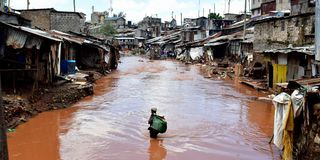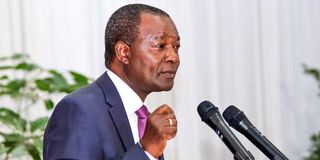State seeks nod to spend Sh10bn on floods crisis

A flooded Mathare River as it passes through Mathare Slums Gitathuru area on April 27, 2024.
What you need to know:
- The unrelenting rains have destroyed crops and property. The government has set up camps to shelter the displaced people.
- The mini-budget of Sh34.92 billion, which includes Sh28.47 billion in recurrent expenditure and Sh6.45 billion in development expenditure, is a reorganisation of the Sh2.37 trillion budget for the national government passed in June 2023.
The government wants the National Assembly to approve Sh10.6 billion to cater for the emergency response to floods and humanitarian crisis caused by heavy rains countrywide.
The details of the allocation are contained in the supplementary budget II for the 2023/24 financial year that is before the National Assembly for post-facto approval.
By Saturday, over 228 people had died due to flooding with thousands injured and others displaced from their homes.
The unrelenting rains have destroyed crops and property. The government has set up camps to shelter the displaced people.
This comes as the Kenya Meteorological Department (KMD) warned of heavy and very heavy rainfall in many parts of the country in the coming days, as the government ramps up humanitarian interventions to minimise loss of lives.
The mini-budget of Sh34.92 billion, which includes Sh28.47 billion in recurrent expenditure and Sh6.45 billion in development expenditure, is a reorganisation of the Sh2.37 trillion budget for the national government passed in June 2023.
The supplementary budget comes against a backdrop of missed targets by the government due to contracting revenue streams.
Of the entire supplementary budget, Sh19.28 billion has already been disbursed to the relevant State agencies, and the National Treasury wants the National Assembly to regularise the expenditure in post-facto approvals as provided in Article 223 of the Constitution.
Also Read: The return of Kenya Kwanza's Tower of Babel
The Article states that the national government may spend money that has not been appropriated if the amount appropriated by the National Assembly is insufficient or if a need — emergency—has arisen for expenditure for a purpose which no amount has been appropriated.
While submitting the mini-budget estimates to the National Assembly, National Treasury Cabinet Secretary Professor Njuguna Ndung’u noted that implementation of the current budget has progressed “smoothly” despite challenges in revenue collection leading to delays in Exchequer releases.
The CS also admitted escalation in debt service, settlement of expenditure carryovers from 2022/23 financial year and settlement of pending bills as other challenges.
“Expenditure pressures arising from increased demand for additional resources to cater for emerging priority spending for interventions such as the El-Nino and security operations,” says Prof Ndung’u.

National Treasury and Economic Planning Cabinet Secretary Njuguna Ndung’u.
The allocation to deal with the floods is spread across government institutions, including response interventions to handle effects of El-Nino that occurred towards the end of last year as well as the drought situation that also hit the country.
At least Sh9 billion of the emergency response intervention budget for floods, El-Nino and drought has already been disbursed.
Apart from floods, El-Nino and drought, the mini-budget has Sh3 billion for national government’s fertiliser subsidy project with State House getting an extra Sh2.5 billion to cater for, among other items, staff emoluments out of which Sh1.2 billion has been disbursed.
The current budget for State House is Sh11.34 billion.
It is not clear why State House failed to budget for emoluments of its workforce during the normal budget-making cycle and now wants the extra amount passed under the supplementary budget.
In January this year, the Public Service Commission (PSC), a State agency which recruits public service employees, said that State House had 483 ghost workers who are not captured in the staff register but are getting paid, nonetheless.
The National Treasury gets an additional Sh7.48 billion out of which Sh4.67 billion goes to finance revenue raising activities of the Kenya Revenue Authority (KRA) and Sh2.02 billion goes to the State Department for Forestry to cater for salary shortfalls.
There is also a Sh671.2 million loan procured from the World Bank for the laying of Eldoret-Nadapal fibre optic cable project, Sh500 million was allocated to the State Department for Cooperatives to mop extra milk and Sh500 million payment for legal dues in the Kenya Railways Corporation (KRC) arbitration case.
The Office of the Deputy President also got an extra Sh463.43 million “to cater for enhancement of operations and maintenance and implementation of alcohol, drug and substance abuse programme”, pushing its budget to Sh4.8 billion.
By the end of March this year, the total revenue collected, including Appropriation-in-Aid (A-I-A) was Sh1.86 trillion, about 11.5 percent of Kenya’s Gross Domestic Product (GDP), against a target of Sh2.13 trillion resulting in a shortfall of Sh270 billion.
The shortfall was mainly attributed to under collection of ordinary revenues by Sh255.1 billion and A-I-A by Sh15.7 billion.
The supplementary budget 1 for this year passed towards the end of last year increased the national government budget to Sh2.46 trillion, supplementary budget II increased the global budget to Sh2.42 trillion — a difference of Sh45.8 million.
The State Department for Internal Security and National Administration gets an extra Sh3 billion for “emergency response interventions on account of El-Nino” and security operations.
However, the budget has not been itemised to know how much went to El-Nino interventions and security.
Out of this allocation, Sh2.3 billion has already been spent, with the National Treasury not providing details on how much went to El-Nino interventions and security operations.
The State Department for Arid and Semi-Arid Lands (ASALs) gets an extra Sh5.4 billion for humanitarian emergency response interventions for people affected by floods and drought, out of which Sh4.3 billion has been disbursed.
The government institutions that got El-Nino emergency interventions include the State Department for Crop Development Sh3.065 million, out of which Sh65 million has been disbursed.
The Ministry of Defence got Sh500 million, the State Department for Roads Sh1 billion for repair of roads damaged by El-Nino, the State Department for Public Works Sh30 million, the State Department for Irrigation Sh70 million and the State
Department for Livestock Development Sh35 million.
Of the Sh2.5 billion in additional allocation to State House, Sh1.5 billion is for the personal emoluments of staff.
The other State agencies that reaped big in the supplementary budget include National Police Service Sh5.42 billion, which will go towards medical and Group Personal Accident (GPA) cover for the police officers and security operations.
Of this amount, Sh2.03 billion has already been expended with Sh2 billion allocated for medical and GPA covers and Sh30 million for security operations.
The State Department for Immigration and Citizen Services got Sh1.57 billion to cater for supplies for production of birth and death certificates booklets, E-passport booklets as well as personal emoluments.
The State Department for Water and Sanitation got Sh604 million, Medical Services received Sh350 million for post-graduate training of health workers, the Ethics and Anti-Corruption Commission (EACC) was given Sh200 million for operations and maintenance and the Executive Office of the President received an extra Sh150 million.
There is also Sh117 million for the State Department for Higher Education and Research to construct centres of excellence, Sh60 million paid for the hosting of the 6th United Nations Environment Assembly (UNEA6). The UNEA6 was held in Nairobi from February 26 to March 1 this year.





